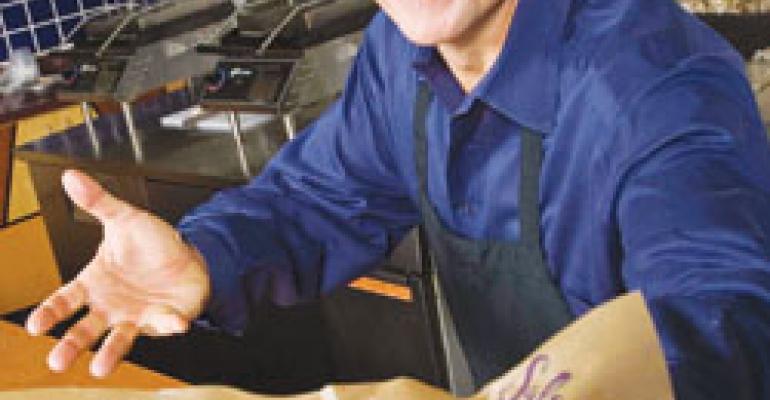As the lingering recession prompts consumers to be more cautious with their dining dollars, restaurant chains are waking up to the opportunities of breakfast catering.
While breakfast has emerged as an increasingly lucrative daypart, some operators find morning catering can help them recoup revenues lost as businesses cut back on lunch spending. Observers say customers often can stretch their food dollars further on less expensive, but higher-margin menu items such as eggs, pastries and coffee.
“Catering is an often overlooked revenue stream for many restaurants,” said Aaron D. Allen, founder and chief executive of Quantified Marketing Group, a consultancy based in Orlando, Fla. “Breakfast catering is therefore even more overlooked, since it’s a niche of catering and requires some specialization.”
He added, “The profits can be tremendous in catering and even higher with breakfast because of the menu.”
The list of operators crowing about the incremental income found in breakfast catering is growing. Salsarita’s Fresh Cantina of Charlotte, N.C., in August made a breakfast-catering program available to its entire 80-unit system. Bruegger’s Enterprises Inc. of Burlington, Vt., which operates the 300-unit bagel chain, plans to test breakfast catering this fall in its Minnesota market. And Camille’s Sidewalk Café of Tulsa, Okla., recently enhanced its 12-year-old breakfast-catering program by giving it a more healthful spin.
Given the ongoing recession, breakfast catering can be a powerful marketing tool, Allen said.
“As budgets tighten, one should be aware that often the price per person for breakfast will be significantly lower to the person/company hiring the caterer than would be catering in lunch or dinner, yet the impact and appreciation of the group being catered is just as high,” he said. “So, if you want to do something nice for your employees and turn to catering, why not start their day off right with breakfast–and save money over a lunch catering?”
Paul Mangiamele, chief executive of Salsarita’s Fresh Cantina, said his company recently expanded catering beyond lunch and dinner after testing its acceptance. “We do it in stores where it makes sense,” he said.
“We had been in the catering space, but it had mostly been lunches and dinners and special events,” Mangiamele said. “But breakfast catering for our type of food, which holds heat well and travels well and has a good presentation and is diverse in flavor profile, is being widely received.”
He noted that breakfast catering is not appropriate for all stores, but “where it’s attractive for the trade area, we’ve seen it gain up to 10 to 12 percent of our sales mix very rapidly.”
There’s also room to capitalize on the country’s growing health consciousness, said Quantified’s Allen.
“Right now coffee, bagel and doughnut places take the lion’s share of the breakfast daypart catering/takeout business,” he said. “As Americans are becoming more conscious of nutrition, this poses an opportunity for caterers going after breakfast with more healthful options.”
Camille Rutkauskas, co-founder and president of Beautiful Brands International of Tulsa, Okla., said she is seeing the shift toward such nutrition awareness in breakfast catering at the 85-unit Camille’s Sidewalk Café chain.
“We’re seeing the protein portion of breakfast catering growing,” Rutkauskas said. “It used to be a lot of danishes and sweets. Now we’re doing very well with our breakfast wraps because of the eggs. Definitely consumers are much more educated about the health aspects of delivered food. They want healthy options like fresh fruits, egg-white omelets and cholesterol-free options. The consumer today is highly educated and really looking to have a choice.… If you don’t have the healthy option, they will go elsewhere.”
Breakfast makes up about 20 percent to 30 percent of Camille’s catering sales, she said, and that has held steady since Camille’s opened its first location in Tulsa in 1997. The size of catered parties range from 10 to thousands for breakfast catering, she said, noting, however, that typically the size ranges from 15 to 25 people.
“The system that works for us is trays in breakfast catering,” she said. “For morning functions, they like the set up of the tray rather than a box, which is typical for lunch.”
Catering also provides a good opportunity for upselling, she said.
“If somebody is just getting breakfast muffins or a danish tray, it’s not that profitable,” Rutkauskas said. “But if you can upsell the customer to coffee service and fruit sides, it’s definitely more profitable. If we have our staff and catering managers trained at the store level, then they can handle it and upsell.”
Operators considering a breakfast-catering program do face some obstacles, said Allen.
“Challenges are mostly found in adapting menus, issues with hold-times and prep, and the potential of neglecting an existing core market chasing a new market,” he said. “These are all easy enough to overcome with proper planning and execution. It’s an issue of proper marketing, operational execution and positioning.”
A good program can appeal to consumers in several ways, he added.
“Two things aren’t going away anytime soon: the recession and the noise around nutrition,” Allen said. “A well-executed breakfast-catering program can address both of these issues while picking up strong streams of incremental revenue and profits.”— [email protected]




